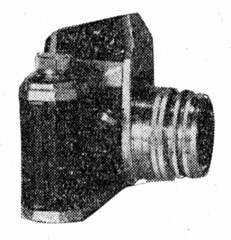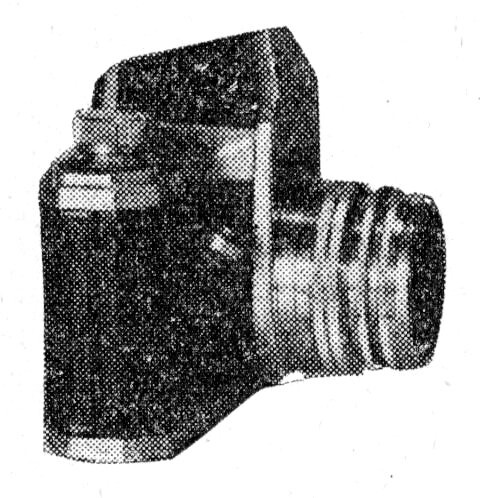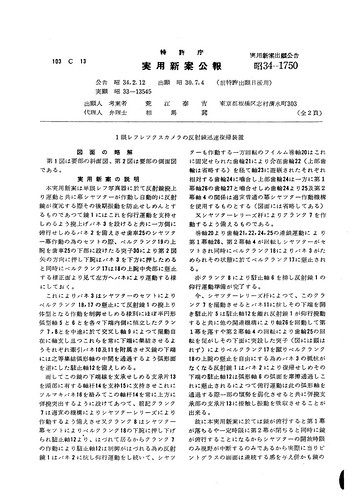Altair

|
| From Asahi Camera February 1955. (Image rights). |
The Altair (アルテア)[1] is a Japanese prototype SLR, announced in early 1955 by Arae Kōgaku. It was closely inspired by the Contax S, and incorporated an instant-return mirror.
Contents
Announcement
The Altair is known from a single article in the February 1955 issue of Asahi Camera.[2] The document says that the camera was designed by Arae Taikichi (荒江泰吉), and also mentions the company Arae Kōgaku,[2] certainly founded especially for the Altair.

|
| Announcement in Asahi Camera February 1955. (Image rights). |
The camera was announced as a prototype only, but it was said that it could appear on the market at the end of March, for around ¥30,000.[2] The resemblance to the Contax S was criticized by the journalist, a sign that times were changing in Japan, and that copying foreign designs was no longer considered normal.[3] For the future, the designer announced the addition of slow speeds, lever advance and a split-image finder.[2]
The article ends saying that it would be good that the camera was made for real, instead of disappearing as had the Phoenix SLR prototype announced in September of the previous year.[2] Ironically, the Altair would never appear again, whereas the Phoenix would return as the Miranda T in mid-1955.
Description of the body

|
| From Asahi Camera February 1955. (Image rights). |
The shape of the body and position of the controls are similar to the Contax S. The main body has angled ends, with eight edges (instead of twelve on the Contax).[4] There is a fixed pentaprism finder offset to the left (as seen by the photographer). Its casing goes down around the lens attachment. The name ALTAIR appears at the front, together with a logo. It is said that the viewfinder included a Fresnel screen.[5]
The film is advanced by a knob at the right end, and rewound by another symmetrical knob. The back opens laterally,[2] perhaps by way of a hinge. The camera can take film cartridges or refillable cassettes (like those of the Canon).[2]
The shutter is of the focal-plane type, and speeds are selected among B, 25, 50, 120, 250, 500, 1000,[2] certainly on a dial between the pentaprism and advance knob. The control seems to protrude from the top plate, and is not the same as on the Contax S. The shutter release is placed as on the German camera, in a slanted position at the front of the body. The camera is synchronized for flash, with FP synch up to 1/50.[2]
Instant-return mirror
 
|
| Utility model publication no.S34-1750, for the instant-return mirror of the Altair. Downloaded from the IPDL, in accordance to the IPDL policies. |
The design contains an instant-return mirror, driven by the shutter. In the Asahi Camera article, the mechanism is described as similar to that of the Asahiflex II, released in late 1954.[6] Arae Taikichi said to the magazine that his patent was examined first, and that it was actually infringed by the Asahiflex.[7] This patent certainly corresponds to the utility model reproduced above, which was applied for in July 1955, and only published in February 1959.[8]
Lenses

|
| Altair with 56/2 and 130/2.1. From Asahi Camera February 1955. (Image rights). |
The lens mount is not known for sure, but the design similarity with the Contax S makes it highly probable that the camera takes 42mm screw lenses. Various lenses were announced. These were designed by Kurebayashi Juichi (樽林寿一), a good friend of Arae Taikichi.[2]
The standard lens fitted on the camera for its announcement in February 1955 was a Rigel Juichi (リゲル・ジュイチ) 56/2, from the star (within Orion) and the designer's given name.[2] Original documents found in recent years indicate that it had an Ernostar design.[4] It was said that a 56/1.4 was being developed and would have been adopted as standard.[2] Both were announced as focusing down to 1.5ft.[2]
The camera was also pictured together with a 130/2.1 tele lens, and 75/2 and 40/2.8 lenses were mentioned as under development or testing.[2]
Search for the Altair
The interest for the Altair was revived among camera historians for the 10th Itabashi Industrial Fair held in November 2006, and research by Hagiya Takeshi led to the discovery of original documents, such as a memo by Arae Taikichi, or photographs taken by the camera.[4] An extended search was conducted throughout Japan: an appeal was published in various newspapers, and a TV spot was planned and perhaps broadcast.[4] Despite these efforts, the fate of the prototype has remained unknown. It is extremely likely that it was destroyed, though it might remain somewhere in Japan or even in the United States, to which it might have been sent for evaluation.
Notes
- ↑ The katakana spelling is アルテア (Arutea) in the column in Asahi Camera February 1955, p.182. Some recent sources use the spelling アルタイル (Arutairu) instead, closer to the actual pronunciation. (See for example the page on the Altair in the official website of Aire Inc.)
- ↑ 2.00 2.01 2.02 2.03 2.04 2.05 2.06 2.07 2.08 2.09 2.10 2.11 2.12 2.13 Column in Asahi Camera February 1955, p.182.
- ↑ Column in Asahi Camera February 1955, p.182. Original text: できるなら、もう少し形態を変えてもらいたい。いかにもコンタックスに似ているから...
- ↑ 4.0 4.1 4.2 4.3 Hagiya, reproduced in Mabuchi.
- ↑ Page on the Altair in the official website of Aire Inc.
- ↑ Column in Asahi Camera February 1955, p.182. Original text: これはアサヒフレックスの新型が、「世界的の発明、クイック・リターン機構」と宣伝しているメカニズムと同じである.
- ↑ Column in Asahi Camera February 1955, p.182. Original text: 荒江氏の言によると、このアルテアの方が先に特許査定を受けたそうで、アサヒレフはこの特許にさしさわるといっている.
- ↑ Japanese utility model publication (実用新案公告) no.S34-1750, available in the j-platpat patent database.
Bibliography
- Arae Taikichi (荒江泰吉). Japanese utility model (実用新案) no.S34-1750. Applied for (出現) on Jul. 4, 1955 and published (公告) on Feb. 12, 1959. Available in the IPDL patent database.
- Asahi Camera February 1955. "Shinseihin memo" (新製品メモ, New products memo). P.182.
- Mabuchi, Sam. "In search of the missing Altair camera". In The PHSC E-mail, vol.6–10, supplement to Photographic Canadiana, Feb. 2007, pp.4–5. Also published in Camera Shopper no.173, Mar. 2007, pp.11–2. (This article contains a partial reproduction of an article by Hagiya Takeshi [萩谷剛] in an unspecified issue of Kurashikku Kamera Senka.)
Links
In Japanese:
- Image of Altair in the official website of Aire Inc., successor of Arae Kōgaku